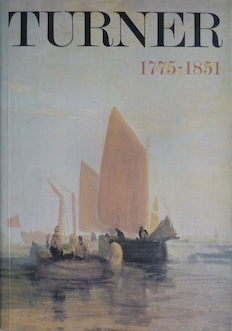|
30 X 2024 |
1. Beginnings 1789-97
019 - Fishermen at Sea 'The Cholmely Sea Piece' | |

| ||
|
The identification of this picture with the work exhibited at the R.A. in 1796 is not fully documented but is strongly supported by the descriptions in two contemporary accounts of the exhibition and by that of the engraver E. Bell (who claimed to have got to know Turner as early as 1795). Reported by Thornbury (1862, 1, p.75 and 1877, p.44), Bell said that 'Turner's first oil picture of any size or consequence was a view of flustered and scurrying fishing-boats in a gale of wind off the Needles, which General Stewart bought for £10'. The Needles can be seen on the left of the painting, but unfortunately there is no evidence to prove that it passed from the General to the Fairfax-Cholmeley family, who owned it by the middle of the nineteenth century. Turner toured the Isle of Wight in 1795, probably during August-September, but none of the sketches in the 'Isle of Wight' sketchbook (T.B.XXIV) are close to the oil painting. However, the painting is close to the larger watercolour apparently from the ‘Cyfarthfa' sketchbook (T.B.XLI-37; the sketchbook is dated c.1798 by Finberg 1909, 1, p.99, and 1799 by Wilkinson 1972, p. 155, but is on paper watermarked 1794 and may have been used on Turner's tour in South Wales in June (?) 1795). Turner later engraved the composition for the Liber Studiorum, R.85 (see p.61; repr. Finberg Liber 1924, p.340) but it was never published (the preliminary drawing is repr. Wilkinson 1974, p. 118). Unlike other early oil paintings such as Nos.33 and 45 this picture is very different in style from Turner’s watercolours of the time. It is rather a highly accomplished example of the tradition of moonlight scenes established by Claude Joseph Vernet, P. J. de Loutherbourg and Joseph Wright of Derby. In particular it resembles the latter's 'Moonlight with a Lighthouse, Coast of Tuscany', exhibited at the Royal Academy in 1789, the year before Turner first showed there, and now at the Tate Gallery. This has the same contrast between the cold light of the moon and the warm light of the man-made lamp, in the lighthouse in the Wright, in the boat in the Turner. This rather intellectual, conceptual interest in light was to become a passionate obsession in Turner's later work. The reflections of light on the water are also close to those in Wright’s picture, but Turner combines them with the illuminated break in the clouds above to create a lozenge-shaped surface pattern that anticipates the vortex-like compositions of so many of his later paintings. Thus, typically of Turner's whole achievement, this painting, while relying on earlier models, anticipates the revolutionary accomplishments of his most advanced work. An image generated by an AI Machine Learning Model Property of the artist. | ||
